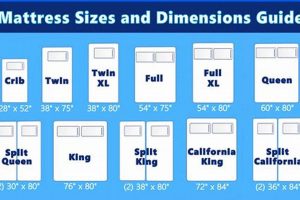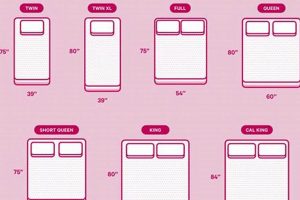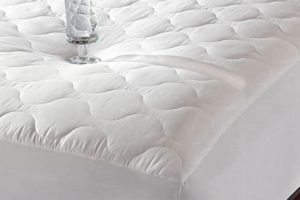The vertical dimension of a mattress, measured from its top surface to its bottom, is a critical factor in determining its overall feel and suitability for individual sleepers. This dimension, typically expressed in inches, ranges from relatively thin profiles to significantly deeper constructions. An example would be a mattress measuring 8 inches, considered a standard thickness, or one reaching 14 inches or more, categorized as a thick or pillow-top model.
The height of a mattress impacts several factors, including ease of getting in and out of bed, aesthetic compatibility with bed frames, and the level of support and cushioning provided. Historically, thinner mattresses were more common; however, advancements in materials and manufacturing techniques have led to increased availability and popularity of thicker options. These thicker options often incorporate multiple layers of foam, coils, or other materials to enhance comfort and support. The correct selection can improve spinal alignment and reduce pressure points, resulting in a more restful sleep experience.
Understanding the implications of various mattress heights is essential for making an informed purchasing decision. The subsequent sections will delve into the specific categories of mattress heights, the factors to consider when choosing a particular height, and the benefits associated with each. This guide aims to provide a comprehensive overview to aid in selecting the most appropriate option for individual needs and preferences.
Considerations for Mattress Height Selection
Selecting the appropriate mattress vertical dimension requires careful consideration of individual needs and preferences. These factors influence overall comfort, support, and the longevity of the sleep product.
Tip 1: Bed Frame Compatibility: Evaluate existing bed frame dimensions to ensure compatibility. A mattress of excessive height may render it disproportionate to the frame, affecting aesthetics and ease of access. Low-profile frames often pair well with thinner mattress models, while taller frames can accommodate thicker mattresses.
Tip 2: Individual Height and Mobility: Personal height and mobility limitations should be factored into the decision. Taller individuals may find thicker mattresses more comfortable for ingress and egress. Individuals with mobility challenges may benefit from a mattress height that minimizes the distance to the floor.
Tip 3: Sleep Position Preferences: Different sleep positions may benefit from specific mattress height profiles. Side sleepers may prefer thicker mattresses for increased cushioning, while stomach sleepers might opt for a slightly thinner profile to maintain spinal alignment.
Tip 4: Body Weight Considerations: Body weight influences the level of support required from a mattress. Individuals with higher body weights may benefit from thicker mattresses with robust support cores to prevent sagging and ensure proper spinal alignment.
Tip 5: Layer Composition and Materials: The types and quantities of materials used within the mattress construction contribute to the overall height. Consider the density and quality of foam layers, coil systems, and other components, as these factors directly affect comfort and durability.
Tip 6: Sheet Depth Requirements: Note that a taller mattress necessitates deep-pocket sheets to ensure a proper fit. Standard-sized sheets may not adequately cover thicker mattresses, resulting in slippage and discomfort.
Selecting the correct vertical dimension of a mattress is vital for optimizing comfort, support, and overall sleep quality. Considering the aforementioned factors can lead to a more informed and satisfying purchasing decision.
The subsequent section will explore specific height categories and their associated benefits.
1. Profile Height
Profile height, when discussing mattress dimensions, refers to the vertical measurement of the mattress from its lowest point to its highest point when lying flat. This dimension is a primary component of overall size, directly influencing the perceived bulk and suitability of the mattress within a given bedroom environment.
- Impact on Bed Frame Selection
The mattress vertical measurement dictates the type of bed frame that can be effectively utilized. Low-profile platforms often necessitate thinner mattresses to maintain an accessible bed height. Conversely, taller bed frames may accommodate thicker mattresses, potentially enhancing comfort and support. A misaligned mattress and frame combination can compromise both aesthetics and functionality.
- Influence on Ease of Entry/Exit
The vertical measurement significantly affects the ease with which individuals can enter and exit the bed. Taller mattresses can pose challenges for individuals with mobility limitations or shorter stature, while excessively low mattresses may require more exertion to rise from. The ideal mattress size promotes comfortable and safe transitions.
- Contribution to Overall Comfort
The mattress dimension plays a role in perceived comfort. Thicker mattresses often incorporate multiple layers of varying densities and materials, potentially enhancing pressure relief and support. Thinner mattresses may provide a firmer feel and are generally less conforming to body contours. The appropriate dimension should align with individual sleep preferences and body weight.
- Effect on Sheet Fit
The mattress height impacts the necessary depth of fitted sheets. Thicker mattresses necessitate deep-pocket sheets to ensure proper coverage and prevent slippage. Standard sheets may not adequately accommodate taller mattresses, resulting in a compromised sleep experience.
In summary, the vertical dimension is not merely a measurement but a crucial factor that influences comfort, accessibility, and overall integration within a bedroom setting. Understanding these interconnected relationships enables consumers to make informed decisions when selecting a mattress that meets individual needs and preferences. Considerations regarding frame compatibility, ease of use, comfort, and the need for appropriate bedding are paramount in the decision-making process.
2. Support Layers
Within the context of mattress thickness, support layers are integral components directly influencing overall height and performance. These layers provide the foundational structure necessary for proper spinal alignment and pressure distribution, impacting the comfort and durability of the mattress.
- Coil Systems and Thickness
Innerspring mattresses rely on coil systems as primary support structures. The gauge and configuration of these coils, whether Bonnell, offset, or pocketed, directly affect the firmness and overall vertical measurement. Higher coil counts and thicker gauge steel often contribute to increased height and enhanced support, particularly for heavier individuals. For example, a mattress with a 10-inch profile might utilize a 6-inch coil system with a specific gauge, while a thicker 14-inch mattress could incorporate an 8-inch coil system for enhanced support.
- Foam Density and Layering
Foam support layers, commonly composed of high-density polyurethane or latex, play a crucial role in distributing weight and minimizing pressure points. Denser foams contribute to greater support and longevity. Variations in foam layering, with strategically placed support zones, can further impact the height and overall feel. Mattresses featuring thicker, multi-layered foam support systems tend to exhibit increased height, providing a more plush and conforming experience. A thin mattress, conversely, may only have a minimal support foam layer, leading to a firmer feel.
- Transition Layers and Height Contribution
Transition layers, often situated between the comfort layers and the primary support core, serve to mediate the feel and prevent direct contact with the firmer base. These layers, typically composed of lower-density foams, add to the overall vertical measurement and contribute to a smoother transition between the surface comfort and underlying support. A mattress lacking substantial transition layers may feel less refined and exhibit a more abrupt change in support.
- Base Foundations and Dimensional Impact
The foundational base of a mattress, constructed from either high-density foam or other durable materials, provides a stable and supportive platform for the upper layers. This base layer contributes significantly to the overall thickness, preventing sagging and ensuring proper weight distribution. Thicker base layers offer enhanced stability and extend the lifespan of the mattress, while thinner bases may compromise support and durability, especially in thicker mattresses.
In summary, the choice of support layer materials and their configuration within a mattress significantly determines its thickness and performance characteristics. Understanding the relationship between support layer components and overall vertical measurement allows for informed selection based on individual support needs and comfort preferences. Variations in coil systems, foam densities, transition layers, and base foundations directly correlate to differences in height and the overall sleep experience.
3. Comfort Layers
Comfort layers, integral to mattress design, directly correlate with the overall dimensions of the mattress. These layers, situated atop the support core, are engineered to provide immediate pressure relief and surface conformability, contributing significantly to the sleep experience. The thickness, density, and composition of these layers inevitably influence the mattress’s vertical measurement. For instance, a mattress marketed as “plush” will typically incorporate thicker comfort layers composed of materials such as memory foam, latex, or fiberfill. These materials, chosen for their ability to contour to the body, add substantial vertical bulk to the mattress. Conversely, a “firm” mattress will often feature thinner comfort layers, or employ higher-density materials that compress less, resulting in a reduced overall height. This direct relationship underscores the practical importance of understanding comfort layer specifications when evaluating mattress dimensions.
The effect of comfort layer thickness extends beyond simple dimensions; it fundamentally alters the way a sleeper interacts with the support core. Thicker comfort layers effectively isolate the sleeper from the underlying structure, providing a more cradling and less resistive surface. This is particularly beneficial for side sleepers, who require enhanced pressure relief at the shoulders and hips. In contrast, thinner comfort layers allow for a more direct engagement with the support core, delivering a firmer, more responsive feel that may be preferred by stomach or back sleepers. Real-world examples of this can be observed in the distinct characteristics of pillow-top mattresses, which feature an additional, typically thick, comfort layer sewn onto the mattress surface, resulting in a significantly greater overall thickness and a softer initial feel, compared to a standard innerspring mattress with minimal surface padding.
In summary, the relationship between comfort layers and mattress thickness is causal and critical. The specific selection and arrangement of materials within these layers directly dictate the overall dimensions of the mattress, and subsequently, its suitability for various sleep preferences and body types. Consumers should carefully consider the composition and thickness of comfort layers when assessing mattress dimensions to ensure the chosen product aligns with their individual needs. This understanding is vital for optimizing sleep quality and avoiding discomfort associated with inadequate pressure relief or insufficient support.
4. Total Dimension
Total dimension, when referring to mattresses, directly embodies the concept of mattress thickness. It represents the cumulative vertical measurement encompassing all layers and components, from the foundational support core to the uppermost comfort layer. The total dimension dictates the overall profile and perceived height, directly influencing compatibility with bed frames, ease of ingress and egress, and the potential for pressure relief and support. A mattress with a significant total dimension, for example, one exceeding 14 inches, often indicates the presence of multiple comfort layers and a robust support system, catering to individuals seeking a plusher feel. Conversely, a mattress with a smaller total dimension, such as 8 inches, typically suggests a firmer sleep surface with less emphasis on conforming comfort. The relationship is thus causal: the thickness and arrangement of constituent layers directly define the total dimension. The total vertical measurement serves as a primary indicator of the mattress’s intended performance characteristics.
Understanding the total dimension provides practical benefits to consumers. It informs the selection of appropriately sized sheets and bed frames, preventing ill-fitting bedding and ensuring a visually cohesive bedroom aesthetic. Further, the total dimension impacts the ergonomic considerations of the sleep system. A mattress with excessive total dimension, when combined with a high bed frame, may present challenges for individuals with limited mobility, while a mattress with insufficient total dimension may result in an uncomfortably low sleep surface. Real-world examples include the growing popularity of low-profile platform beds, which necessitate mattresses with reduced total dimension to maintain accessible bed heights. Similarly, adjustable bed bases require mattresses with a degree of flexibility, a characteristic that can be affected by excessive total dimension.
In summary, the total dimension serves as a fundamental aspect of mattress description and informs multiple practical considerations. Acknowledging its role as the aggregated vertical measurement clarifies its connection to the broader concept of mattress thickness. Challenges arise when marketing materials fail to provide precise total dimension specifications, hindering consumers’ ability to make informed decisions. The accurate portrayal of total dimension, alongside detailed descriptions of constituent layers, facilitates a more transparent and effective selection process, aligning consumer expectations with the actual performance characteristics of the product.
5. Edge Support
Edge support, in the context of mattress construction, is directly related to overall mattress dimensions. It refers to the reinforcement provided along the perimeter of the sleep surface, designed to prevent sagging and maintain structural integrity. The effectiveness of edge support is often influenced by the materials used and their arrangement, factors which intrinsically impact the mattress’s overall vertical size. Thicker mattresses frequently incorporate enhanced edge support systems, involving high-density foam encasements or specialized coil configurations. These additions contribute to the overall profile and ensure a consistent level of support across the entire surface, reducing the likelihood of roll-off and maximizing usable sleeping area. The absence of adequate edge support, particularly in thicker mattresses with multiple comfort layers, can lead to premature wear and a compromised sleep experience.
The correlation between edge support and the mattress vertical dimension is evident in various mattress types. Hybrid mattresses, which combine innerspring systems with foam or latex layers, commonly feature reinforced edges to counteract the potential for compression of the softer comfort materials. The edge support may consist of high-density foam rails surrounding the innerspring unit, increasing the overall height. Similarly, all-foam mattresses may utilize denser foam formulations at the perimeter to provide added stability and prevent edge collapse. A practical example is seen in mattresses designed for couples, where edge support becomes critical to ensure each sleeper can utilize the full width of the mattress without experiencing a noticeable decline in support. This reinforces the impact on usable sleeping area.
In conclusion, edge support is an integral component of mattress design, inextricably linked to the overall dimensions. The inclusion of robust edge support systems, often necessitating increased vertical measurement, directly influences the longevity, usability, and overall comfort of the mattress. A lack of understanding regarding the importance of edge support, particularly when assessing mattresses of varying thicknesses, can lead to suboptimal purchasing decisions and a diminished sleep experience. Therefore, when evaluating mattresses, the integration and effectiveness of the edge support mechanism should be carefully considered in conjunction with the total dimension.
6. Frame Compatibility
The correlation between frame compatibility and mattress dimensions is direct and consequential. Frame compatibility dictates the suitable range of mattress vertical sizes that can be accommodated without compromising structural integrity or aesthetic balance. A frame designed for thinner mattresses, when paired with a thicker model, may exhibit inadequate support, resulting in mattress sagging or instability. Conversely, a frame intended for thicker mattresses may leave an excessive gap when used with a thinner option, impacting aesthetics and potentially reducing edge support. The selection of an appropriate mattress vertical size must, therefore, consider the frame’s load-bearing capacity and dimensional constraints. This relationship is causal: the frame’s design determines the acceptable range of mattress height for safe and effective use.
The importance of frame compatibility is readily apparent in practical scenarios. Platform beds, for example, often necessitate thinner mattresses to maintain an accessible bed height and avoid obstructing headboards. Slat systems require sufficient contact with the mattress to provide adequate support, a condition which can be compromised by improper vertical dimension matching. Bunk beds have strict vertical size limitations to ensure compliance with safety standards, dictating that only thinner mattresses be used. The failure to adhere to frame compatibility guidelines can lead to structural damage, warranty voidance, and, in extreme cases, potential injury. Real-world examples underscore the necessity of considering the frame’s specifications when selecting a mattress to ensure proper support and safety.
In summary, frame compatibility is a fundamental consideration in mattress selection, directly linked to the overall dimensions. Understanding the dimensional limitations of a bed frame, and selecting a mattress accordingly, prevents structural issues, maximizes comfort, and ensures long-term usability. Misalignment between frame design and mattress height negatively impacts both aesthetics and performance. Careful attention to compatibility is, therefore, essential for a successful sleep system configuration.
7. Sheet Fit
Proper sheet fit is inextricably linked to mattress vertical dimension. Inadequate consideration of mattress height during sheet selection can result in ill-fitting bedding, compromising comfort and aesthetics. The depth of fitted sheets, specifically, must correspond to the thickness of the mattress to ensure secure and complete coverage.
- Pocket Depth and Mattress Height
Pocket depth refers to the measurement of the fitted sheet’s corner from the seam to the deepest point. This dimension must be sufficient to fully encapsulate the mattress corner without undue stretching or slippage. Standard pocket depths typically range from 9 to 12 inches, suitable for thinner mattresses. Deeper pocket sheets, ranging from 13 to 17 inches or more, are required for thicker mattresses, including those with pillow tops or added layers. A mattress measuring 14 inches in height, for example, necessitates deep-pocket sheets to ensure adequate fit and prevent the sheet from detaching during use.
- Consequences of Mismatched Sheets
Using sheets with insufficient pocket depth on a thick mattress results in several adverse outcomes. The fitted sheet may repeatedly slip off the corners, requiring frequent readjustment and disrupting sleep. The stretched fabric can weaken and tear prematurely, reducing the sheet’s lifespan. Furthermore, the tight fit can compress the comfort layers of the mattress, potentially affecting its performance and longevity. Conversely, using excessively deep-pocket sheets on a thinner mattress can lead to a loose and wrinkled surface, diminishing comfort and aesthetics.
- Material Considerations and Stretch
The material composition of sheets also influences fit. Some fabrics, such as cotton blends with elastic fibers, offer greater stretch and adaptability, accommodating slight variations in mattress height. However, even with stretchable materials, exceeding the recommended pocket depth range can still lead to fit issues. Non-stretch fabrics, like percale, require more precise matching of pocket depth and mattress height to ensure a secure fit. The material’s ability to conform to the mattress’s contours is therefore a crucial factor in sheet selection.
- Marketing and Misrepresentation
Marketing of sheet sets can sometimes be misleading regarding pocket depth compatibility. Some manufacturers may overstate the pocket depth range or fail to account for shrinkage after washing. Consumers should carefully examine product specifications and reviews to ensure accurate information. Measuring the mattress height and comparing it to the sheet’s stated pocket depth is essential before purchase. Reliance solely on marketing claims can lead to purchasing unsuitable bedding.
The relationship between sheet fit and mattress vertical dimension underscores the need for precise measurements and informed purchasing decisions. Failure to consider this relationship leads to compromised comfort, reduced product lifespan, and potential financial loss. Accurate assessment of mattress vertical measurement combined with informed sheet selection is necessary for optimal sleep quality and bedding longevity.
Frequently Asked Questions
This section addresses common inquiries and misconceptions regarding mattress vertical dimensions, providing clarity on factors influencing proper selection.
Question 1: How is mattress thickness sizes accurately measured?
Mattress thickness is determined by measuring the vertical distance from the uppermost surface to the lowermost surface while the mattress is resting on a flat, level surface without any external load. It is essential to ensure the measurement is taken at multiple points to account for any variations in construction.
Question 2: What role do mattress thickness sizes play in overall support?
Thickness directly influences support capabilities. Thicker mattresses often incorporate more substantial support cores and multiple comfort layers, enhancing spinal alignment and pressure distribution. However, thickness alone does not guarantee superior support; material density and construction methods are also crucial.
Question 3: How do mattress thickness sizes impact sheet selection?
Mattress thickness dictates the required pocket depth of fitted sheets. Thicker mattresses necessitate deep-pocket sheets to ensure complete coverage and prevent slippage. Standard sheets may not adequately accommodate thicker mattresses, leading to discomfort and premature wear.
Question 4: Are there specific recommendations of mattress thickness sizes based on body weight?
Individuals with higher body weights typically benefit from thicker mattresses, as they offer enhanced support and prevent excessive compression of comfort layers. Thinner mattresses may be suitable for lighter individuals. As a general guideline, individuals over 200 pounds should consider mattresses exceeding 12 inches in thickness.
Question 5: What are the primary disadvantages associated with excessively thick mattresses?
Excessively thick mattresses can pose challenges related to bed frame compatibility, ease of getting in and out of bed, and the potential for increased heat retention. Transportation and handling may also be more difficult due to their weight and bulk.
Question 6: How can consumers accurately assess the true thickness of a mattress during online shopping?
Consumers should carefully examine product specifications and seek out detailed product descriptions. Scrutinizing user reviews and cross-referencing information from multiple sources can provide a more comprehensive understanding of actual mattress thickness. Contacting the manufacturer or retailer directly for clarification is recommended if discrepancies exist.
Selecting the correct mattress size involves a careful consideration of individual needs, body type, and bed frame compatibility. The information contained in this FAQ provides a solid basis for making an informed decision.
The next section will address the common types of mattresses.
Conclusion
The preceding exploration of “mattress thickness sizes” has highlighted the multifaceted nature of this critical mattress attribute. From influencing bed frame compatibility to dictating sheet fit and impacting overall support, vertical measurement plays a pivotal role in the sleep experience. Careful consideration of these factors is essential for aligning individual needs with product characteristics. A comprehensive understanding of support structures, comfort layer composition, and edge support systems, all contributing to overall height, enables informed decision-making.
The selection of a mattress is a significant investment in personal well-being. A continued emphasis on transparent product specifications and accurate dimensional portrayals is paramount. While individual preferences remain a key determinant, objective assessment based on the principles outlined herein will contribute to a more satisfactory outcome.


![Best Queen Size Mattress with Boxspring [Deals!] Organic & Natural Mattress Buyer’s Guide: Non-Toxic Sleep Solutions Best Queen Size Mattress with Boxspring [Deals!] | Organic & Natural Mattress Buyer’s Guide: Non-Toxic Sleep Solutions](https://mattressworldpa.com/wp-content/uploads/2025/07/th-2253-300x200.jpg)
![Futon vs Reg Mattress Size: Are They The Same? [Guide] Organic & Natural Mattress Buyer’s Guide: Non-Toxic Sleep Solutions Futon vs Reg Mattress Size: Are They The Same? [Guide] | Organic & Natural Mattress Buyer’s Guide: Non-Toxic Sleep Solutions](https://mattressworldpa.com/wp-content/uploads/2025/07/th-2252-300x200.jpg)



